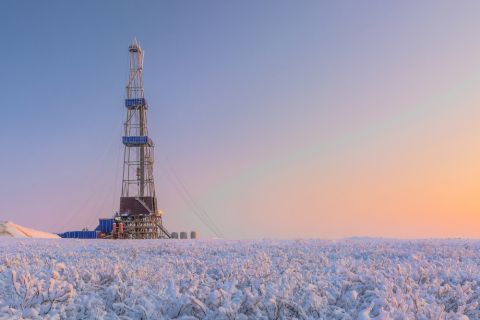News is starting to come out of Mexico, and it’s good news.
Some of the long-awaited multiclient data that have been acquired over the past few months on the Mexican side of the Gulf of Mexico (GoM)were revealed during a session at the recent Offshore Technology Conference, and it’s pretty amazing stuff. One image reminded me of a child’s finger painting, all rolypoly and complex. Now that PEMEX no longer has a monopoly on Mexico’s deepwater acreage, and now that the country is offering up deepwater blocks in its Round 1.4 licensing round, it should be off to the races for the world’s deepwater players.
Brian Horn from ION Geophysical described a program that, for the first time, gives a basin perspective on the GoM. A 5,800-km (3,604-mile) 2-D program was stitched together from previous surveys using well control for stratigraphic calibration. Data from 300 wells were used.
Up until now the updip data have been missing. By remigrating the legacy data to create a composite dataset, it’s now obvious where the sediment is coming from, and interpreters can use the dataset to see across the entire basin.
The company also has created a velocity cube of the entire basin, and it’s possible to pick the top of the Cretaceous off of this cube, he said.
One of the most interesting aspects of Horn’s talk was the potential for a presalt play in Mexico’s southern waters. Referring to an image, Horn said, “This looks like the Campos Basin.” Whether there are hydrocarbons beneath will require further exploration, of course.
Horn also has had access to some of the 3-D data provided by the Comisión Nacional de Hidrocarburos (CNH), and he said these data, though narrow-azimuth, are “more than adequate” in most areas he’s studied. “There’s potential in the Cretaceous and Jurassic,” he said.
Duncan Bate of TGS explained that Mexico makes it easy for these companies to explore. “CNH has developed an effective process in a short time,” he said, adding that qualified companies are approved to acquire data in any area that has been earmarked for future bid rounds. Multiple companies can acquire data in the same area, he added.
While the state owns the datasets, the company that acquires them is allowed to license them for 12 years after acquisition.

Recommended Reading
Wayangankar: Golden Era for US Natural Gas Storage – Version 2.0
2024-04-19 - While the current resurgence in gas storage is reminiscent of the 2000s —an era that saw ~400 Bcf of storage capacity additions — the market drivers providing the tailwinds today are drastically different from that cycle.
Biden Administration Criticized for Limits to Arctic Oil, Gas Drilling
2024-04-19 - The Bureau of Land Management is limiting new oil and gas leasing in the Arctic and also shut down a road proposal for industrial mining purposes.
SLB’s ChampionX Acquisition Key to Production Recovery Market
2024-04-19 - During a quarterly earnings call, SLB CEO Olivier Le Peuch highlighted the production recovery market as a key part of the company’s growth strategy.
PHX Minerals’ Borrowing Base Reaffirmed
2024-04-19 - PHX Minerals said the company’s credit facility was extended through Sept. 1, 2028.
Exclusive: The Politics, Realities and Benefits of Natural Gas
2024-04-19 - Replacing just 5% of coal-fired power plants with U.S. LNG — even at average methane and greenhouse-gas emissions intensity — could reduce energy sector emissions by 30% globally, says Chris Treanor, PAGE Coalition executive director.





